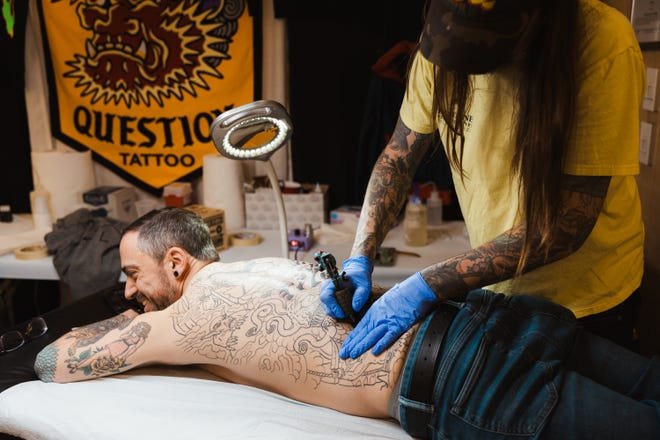Made-to-Fade Tattoos May Play a Pivotal Role in Radiation Treatment for Cancer

Introduction
Traditional radiation-marking tattoos have long been used in medical settings to ensure accurate patient positioning during radiation treatment for cancer. These permanent tattoos, created using ink that remains visible for a lifetime, serve as reference points for healthcare professionals to deliver precise and targeted radiation therapy. However, while effective in their purpose, these permanent tattoos come with limitations and potential drawbacks.
The Promise of Made-to-Fade Tattoos
Made-to-fade tattoos offer a promising alternative for cancer patients undergoing radiation treatment. Unlike traditional permanent markers, these temporary tattoos are designed to fade over time, providing a more patient-friendly solution. Made-to-fade tattoos are created using specialized ink that gradually dissipates, eliminating the need for laser tattoo removal after the radiation treatment is completed.
The concept of made-to-fade tattoos brings several advantages for both patients and healthcare professionals:
- Addressing Patient Concerns: By being temporary, these tattoos address concerns such as long-term skin changes and the psychological impact of permanent markings. Patients can feel more at ease knowing that the tattoos will naturally disappear without any additional procedures.
- Enhancing Treatment Precision: Made-to-fade tattoos offer flexibility for healthcare professionals during treatment planning and delivery. They can easily be adjusted or removed as needed, providing greater precision in patient positioning without the limitations associated with permanent markers.
In this article, we will explore the benefits of made-to-fade tattoos in radiation treatment for cancer, examine a key study on their safety and efficacy, discuss future advancements in ink technologies, highlight the importance of collaboration between healthcare providers and tattoo artists, empower patients through education and advocacy, and conclude with a call to support further research in this promising field.
Understanding Radiation Treatment and the Need for Accurate Patient Markings
Radiation treatment is a common method used to target and destroy cancer cells in the body. It involves using high-energy radiation beams like X-rays or protons to damage the DNA within cancer cells, stopping them from growing and dividing further. This helps shrink tumors and ease cancer symptoms.
During each radiation therapy session, it’s crucial to position the patient accurately. This ensures that the tumor is targeted precisely while minimizing harm to healthy tissues nearby. By directing the radiation beams specifically at the tumor site, we can make them more effective and reduce the risk of damaging other organs or structures.
The Importance of Accurate Patient Positioning
Accurate patient positioning is crucial during each radiation therapy session to ensure precise targeting of the tumor while minimizing damage to healthy surrounding tissues. The radiation beams need to be directed specifically at the tumor site to maximize their effectiveness and reduce potential harm to nearby organs or structures.
To achieve this level of precision, medical professionals rely on patient markings. These markings serve as reference points for aligning the patient’s body in the same position for each treatment session, ensuring consistent delivery of radiation therapy. Traditionally, permanent tattoos have been used for this purpose, providing durable markers on the patient’s skin that can be easily identified by healthcare providers.
However, traditional permanent tattoos have limitations in medical use cases. They can cause discomfort during application and may pose challenges for patients who are concerned about having visible marks on their bodies long after treatment is complete. Additionally, these tattoos can lead to long-term skin changes, such as pigmentation alterations or scarring.
The Advantages of Made-to-Fade Tattoos
In light of these limitations, made-to-fade tattoos offer a promising alternative for cancer patients undergoing radiation treatment. These temporary tattoos are designed to fade over time, providing accurate patient markings during treatment and gradually disappearing afterward. This innovative approach not only addresses patient concerns about permanent visible marks but also eliminates the need for tattoo removal procedures once radiation therapy is finished.
By using made-to-fade tattoos, healthcare professionals can ensure precise patient positioning throughout the course of radiation treatment while minimizing any potential long-term skin changes associated with traditional permanent markers. This temporary nature of made-to-fade tattoos offers an improved patient experience and enhances flexibility for healthcare providers in delivering accurate and personalized radiation therapy.
The Benefits of Ephemeral’s Made-to-Fade Tattoos in Ensuring Precision and Safety
Ephemeral’s tattoo ink stands out for its unique properties that make it suitable for use in made-to-fade tattoos. The ink is composed of biodegradable components and is designed to undergo a controlled fading process over time. This distinctive feature addresses the limitations of traditional permanent markers used in radiation treatment for cancer patients.
Unique Properties of Ephemeral’s Ink
- Biodegradable Components: Ephemeral’s ink is formulated with biodegradable materials that enable it to gradually break down within the body, offering a temporary solution for medical markings. This feature aligns with the evolving needs of cancer patients undergoing radiation therapy, as it eliminates the long-term presence of visible markings associated with traditional tattoos.
- Controlled Fading Process: The ink’s controlled fading process ensures that the markings gradually diminish over time, minimizing the need for additional interventions or removal procedures after the completion of radiation treatment. This controlled dissipation contributes to a more patient-friendly experience, reducing the psychological impact of enduring permanent reminders of their cancer journey.
Benefits in Radiation Treatment for Cancer
- Improved Patient Experience: Made-to-fade tattoos created with Ephemeral’s ink enhance the overall patient experience by offering a temporary yet reliable method for accurate patient positioning during radiation therapy sessions. Patients benefit from knowing that the markings will naturally fade without requiring specialized removal processes, providing them with a sense of closure and progress after completing their treatment.
- Enhanced Flexibility for Healthcare Professionals: Healthcare professionals administering radiation therapy gain increased flexibility in marking and positioning patients, without concerns about long-term skin changes or complications associated with permanent tattoos. This adaptability contributes to more precise and personalized treatment delivery, aligning with the evolving standards of patient-centered care in oncology.
- Reduced Risk of Long-Term Skin Changes: By utilizing made-to-fade tattoos with Ephemeral’s ink, cancer patients are less likely to experience long-term skin changes or adverse reactions often associated with permanent tattooing methods. This reduction in potential skin alterations supports better skin health and quality of life for individuals undergoing radiation treatment, aligning with holistic approaches to cancer care and ensuring a comprehensive well-being throughout their recovery journey.
The benefits offered by Ephemeral’s made-to-fade tattoos underscore their potential to revolutionize radiation treatment for cancer patients. As this innovative approach gains traction, it sets a new standard for precision, safety, and patient-centered care within the realm of oncology. This is further supported by recent studies published in prominent scientific journals such as ACS Applied Bio Materials which validate the effectiveness and viability of these advancements.
A Key Study on the Safety, Efficacy, and Visibility of Made-to-Fade Tattoos
In a significant advancement for cancer treatment, a safety and efficacy study was conducted to evaluate the use of made-to-fade tattoos in radiation therapy for cancer patients. This study aimed to assess the reliability and visibility of these tattoos compared to traditional permanent markers, providing valuable insights into their potential impact on patient care.
Study Overview
The study involved a group of cancer patients undergoing radiation treatment, with a focus on the use of made-to-fade tattoos for precise patient marking. The research included interviews with the patients and evaluations by radiation oncologists, aiming to thoroughly assess the safety, effectiveness, and visibility of these innovative medical markings.
Findings and Insights
The findings from this study reveal the advantages of made-to-fade tattoos in radiation therapy for cancer patients. By comparing these tattoos with traditional permanent markers, the study uncovered important information that can improve patient care and treatment outcomes.
1. Patient Experiences
One key part of the study looked at how cancer patients felt about receiving made-to-fade tattoos during their radiation therapy. Their feedback gave us valuable information about how comfortable and long-lasting these temporary markings were, as well as any emotional effects they might have experienced.
2. Assessment by Radiation Oncologists
Radiation oncologists also played a crucial role in this study by evaluating how practical and effective made-to-fade tattoos were in real medical settings. Their expertise helped us understand how well these tattoos stayed visible over time and how accurately they could guide treatment.
Implications for Cancer Treatment
The results of this study show that made-to-fade tattoos are a better option than permanent markers for marking patients during radiation therapy. Both patient experiences and expert assessments highlighted several benefits:
- Improved Accuracy: Made-to-fade tattoos were found to be more precise in guiding treatment than traditional markers.
- Reduced Long-Term Skin Changes: Unlike permanent markers, these tattoos fade away naturally after treatment, minimizing any long-term effects on the skin.
- Enhanced Overall Safety: The temporary nature of these tattoos reduces the risk of errors or confusion in future medical procedures.
By combining scientific research with practical use, this study has opened doors for wider acceptance of made-to-fade tattoos as a reliable and patient-friendly choice for marking cancer patients during radiation therapy.
The Potential of Innovative Ink Technologies for Future Advancements
As the use of made-to-fade tattoos in radiation treatment for cancer continues to gain traction, there is a growing need for further advancements in the field of temporary medical markings. While Ephemeral’s ink has proven to be a promising solution, researchers and scientists are exploring other innovative ink technologies that could offer even more benefits and possibilities in the future.
Here are some key areas of exploration and potential future directions:
- Invisible Ink: One intriguing concept being explored is the use of invisible ink for medical markings. Invisible ink offers several advantages, including aesthetics and discretion. Patients undergoing radiation therapy may prefer invisible markings that are not visible on their skin during their day-to-day activities. Furthermore, invisible ink can provide accurate fading timelines without leaving any visible trace once the treatment is completed.
- UV-Reactive Ink: Another area of interest is UV-reactive ink, which has the ability to become visible under specific lighting conditions. This technology could be particularly useful in cases where enhanced visibility is crucial, such as patients with darker skin tones or when precise alignment is required for complex treatment plans. UV-reactive ink could provide a clear and easily distinguishable marking that ensures accurate patient positioning during each radiation session.
It’s important to note that while these ink technologies show promise, further research and development are needed to fully explore their potential applications in radiation treatment for cancer. Scientists and tattoo artists continue to collaborate to refine these technologies and address any challenges or limitations they may present.
By pushing the boundaries of temporary medical markings, researchers aim to improve patient experience, enhance accuracy, and ensure optimal outcomes in radiation therapy. These innovative ink technologies have the potential to revolutionize the field by providing more personalized and patient-friendly solutions.
Collaboration Between Healthcare Providers and Tattoo Artists: Bridging the Gap
Collaboration between healthcare providers, cancer treatment facilities, and skilled tattoo artists plays a pivotal role in driving acceptance and innovation in the use of made-to-fade tattoos for radiation therapy. By working together, these stakeholders can establish best practices and ensure high standards of quality and safety in this emerging field.
Here are some key points highlighting the importance of collaboration:
1. Sharing expertise
Healthcare providers bring their medical knowledge and understanding of patient needs, while tattoo artists contribute their artistic skills and experience in creating precise and visually appealing designs. This collaboration allows for the development of customized made-to-fade tattoos that meet both medical requirements and patient preferences.
2. Establishing protocols
By collaborating closely, healthcare providers and tattoo artists can develop standardized protocols for applying made-to-fade tattoos in radiation therapy. These protocols ensure consistency across different treatment facilities, reducing the risk of errors or variations in practice.
3. Training and education
Collaboration between healthcare providers and tattoo artists enables knowledge sharing through training programs and workshops. This ensures that tattoo artists have a comprehensive understanding of the specific needs and challenges associated with radiation therapy markings. Likewise, healthcare providers gain insights into the technical aspects of tattoo application, enhancing their ability to communicate effectively with tattoo artists.
4. Quality control
Through collaboration, healthcare providers can partner with reputable tattoo artists who are experienced in creating medical-grade made-to-fade designs. This collaboration helps ensure that the tattoos are applied safely, accurately, and with an emphasis on patient comfort. Regular communication between healthcare providers and tattoo artists allows for ongoing feedback to maintain high standards of quality control.
Successful initiatives have already demonstrated the power of collaboration between healthcare providers, cancer treatment facilities, and tattoo artists:
- The Memorial Sloan Kettering Cancer Center in New York City has established a dedicated program that brings together radiation oncologists, nurses, medical physicists, and specially trained tattoo artists. This collaboration ensures that patients receive personalized and accurate made-to-fade tattoos that meet their individual treatment needs.
- The University of Texas MD Anderson Cancer Center has also embraced collaboration with tattoo artists to enhance patient experience during radiation therapy. By partnering with skilled tattoo artists, they have developed a comprehensive training program to ensure consistent and high-quality markings for their patients.
By bridging the gap between healthcare providers and the tattoo industry, these successful collaborations have paved the way for wider adoption of made-to-fade tattoos in radiation therapy. They serve as examples of how teamwork and shared expertise can drive acceptance and innovation in the medical field.
Empowering Patients Through Education and Advocacy
Patient advocacy groups and educational resources are crucial in raising awareness about the benefits and availability of made-to-fade tattoos for radiation treatment. These organizations provide support and information to empower cancer patients undergoing radiation therapy, helping them make informed decisions about their medical markings.
1. Accessing Support and Information
By actively engaging with patient advocacy groups, individuals can gain access to a wealth of knowledge and support networks. These groups often offer:
- Educational materials
- Workshops
- Online resources
These resources cover various aspects of cancer treatment, including the use of temporary tattoos for accurate patient markings during radiation therapy. Additionally, they provide platforms for sharing personal experiences, insights, and tips related to navigating the challenges of cancer treatment.
2. Equipping Patients with Knowledge
Educational resources contribute to empowering patients by giving them the information they need to advocate for their own care. Patients are encouraged to:
- Seek information about made-to-fade tattoos
- Discuss their options with healthcare providers
Accessing reliable educational materials can help individuals understand the advantages of temporary medical markings and make well-informed choices that align with their preferences and treatment needs.
3. Raising Awareness for Better Options
Raising awareness about made-to-fade tattoos for radiation treatment is essential in ensuring that patients are well-informed about this innovative option. Through advocacy efforts and educational outreach, individuals can learn about the benefits of using temporary tattoos instead of permanent markers. This increased awareness empowers patients to explore alternative marking solutions that offer:
- Greater flexibility
- Reduced long-term impact on their skin
It’s important for readers to recognize the significance of seeking out reputable tattoo artists who have experience in creating medical-grade made-to-fade designs. By advocating for themselves and actively participating in discussions with healthcare providers, patients can ensure that they receive accurate and reliable information regarding the use of temporary tattoos for radiation therapy. This collaborative approach between patients, advocacy groups, and healthcare professionals contributes to a more informed decision-making process.
Patient advocacy groups and educational resources serve as valuable pillars of support for individuals undergoing radiation treatment for cancer. By engaging with these resources, patients can gain knowledge, confidence, and a sense of empowerment in making decisions that align with their preferences and well-being. Advocacy efforts contribute to raising awareness about the availability and benefits of made-to-fade tattoos, ultimately enabling patients to take an active role in their journey towards improved treatment experiences.
Conclusion
Made-to-fade tattoos have the potential to revolutionize the field of radiation treatment for cancer by offering a safer and more patient-friendly alternative to traditional permanent markers. The temporary nature of these tattoos allows for accurate patient positioning during each session while minimizing the long-term effects on the skin.
By using Ephemeral’s ink, which is specially designed to fade over time, patients can avoid the need for laser tattoo removal after their radiation treatment is finished. This not only improves the patient experience but also reduces the risk of long-term skin changes.
It is crucial to encourage further research support for scientific advancements in this area. Collaboration between scientists, tattoo artists, healthcare professionals, and patients is essential to drive innovation and improve the effectiveness of made-to-fade tattoos in radiation therapy.
Patient advocacy groups and educational resources play a valuable role in raising awareness about the benefits and availability of made-to-fade tattoos for cancer treatment. Patients are encouraged to proactively seek information, consult with their healthcare providers, or find reputable tattoo artists experienced in creating medical-grade made-to-fade designs.
Call to Action: Let us come together as a community to support and promote further research on made-to-fade tattoos and their applications in radiation treatment for cancer. By fostering collaboration between different stakeholders, we can continue to drive innovation in this promising field and ultimately improve the lives of cancer patients undergoing radiation therapy.









